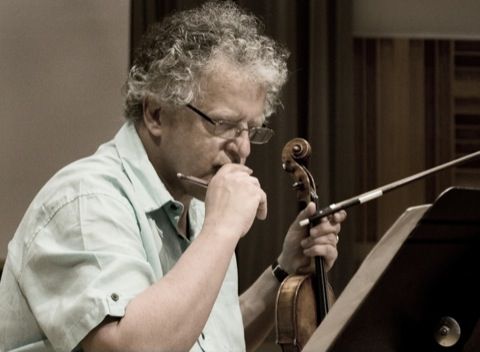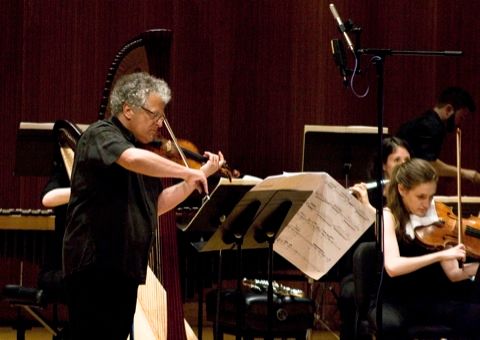 |
| Irvine Arditti during a JiB 2014 composer workshop |
Working closely with composers is of great importance to Arditti. His introduction to the new music world happened at age 12, when he met Messiaen and Xenakis at the English Bach Festival. Just a few years later he was studying at the Darmstadt summer courses, with the likes of Stockhausen and Boulez. For Arditti, working with composers is a key part of the adventure. "I love the idea of going to the limit of what you can do," he says. "With the music I and my quartet play […] it’s all to do with getting inside a living composer’s mind. There is no performing tradition. We have to create it, we have to turn these very odd-looking marks into music which has never been heard before."
Perhaps the most well known account of Arditti's virtuosity has to do with John Cage's Freeman Etudes. The famously difficult piece has been called "impossible" by James Pritchett, who compared its requirements to "a track and field athlete who must run, jump, and throw, but do so in rapid succession, and, at the same time, to have a dancer's control of the body, so that the feet always land in precise locations, the arms and legs bent at precise angles." Cage, who used star maps and the I Ching to determine most of the work's musical material, originally composed the work for a virtuoso violinist, who, upon seeing the first completed etudes, deemed them "quite unplayable." Discouraged by this verdict, Cage abandoned the project, until they were picked up years later by Arditti, who was not only able to perform the piece, but performed it faster than the notated tempo(!), inspiring Cage to complete the project. In fact, Arditti—following Cage's performance note that the piece should be performed in "as short a time-length as [the player's] virtuosity permits"—has continued to increase the piece's tempo with each performance (see a recent performance below). With regard to the etudes' difficulty, Cage said, "These are intentionally as difficult as I can make them, because I think we're now surrounded by very serious problems in the society, and we tend to think that the situation is hopeless and that it's just impossible to do something that will make everything turn out properly. So I think that this music, which is almost impossible, gives an instance of the practicality of the impossible." Or, in Arditti's words, "Nothing is impossible if you rehearse it enough."
Arditti has been an important presence at June in Buffalo for many years, both as a soloist and as part of the Arditti Quartet. In 2007, the Ardittis were a resident ensemble at the festival, workshopping student pieces and presenting a concert of works including Roger Reynold's Ariadne's Thread, David Felder's Stuck-Stücke, and Lachenmann's String Quartet No. 3 "Grido", all of which were composed specifically for the quartet (indeed, the latter takes its name from the name of the quartet's members—the "i" in "Grido" is for "Irvine"). In 2010, the quartet returned for two sessions of student workshops, as well as another evening concert of exciting music, including Reynolds' Not Forgotten, Felder's Third Face, Xenakis's Tetras, and Feldman's early quartet, Structures (1951). That same year, Arditti performed Reynolds' Aspiration with the Slee Sinfonietta, another work composed for the violinist. In 2011, Arditti returned as a special guest to play two works on a chamber music concert: Hilda Paredes's Memoriam Thomas Kakuska and Salvatore Sciarrino's Sei Caprici—the latter, an extraordinary tour de force and study in extended string techniques, made a particular impression on the young composers present, with both the work's inherent virtuosity and Arditti's bold performance acting as a demonstration of the amazingly extensive sound-world of the violin.
 |
| Arditti performs Paredes's Señales with SIGNAL at JiB 2014 |
This anniversary year, Arditti will return for another solo recital of adventurous string music, including Ferneyhough's labyrinthine Unsichtbare Farben and Reynolds' Kokoro (both dedicated to the violinist), as well as Feldman's For Aaron Copland and Elliott Carter's famous Duo for Violin and Piano—definitely not a performance to miss. As Tom Service has noted, "Any Arditti performance is not just an interpretation, but a performance informed by decades of the subtle oral tradition of working with the world's greatest composers. They are living, breathing music history." Indeed, and not just a living history, but a demonstration of the "practicality of the impossible."
—Ethan Hayden



